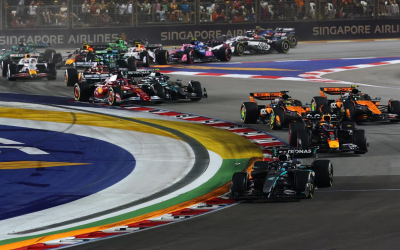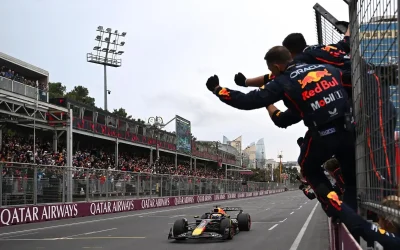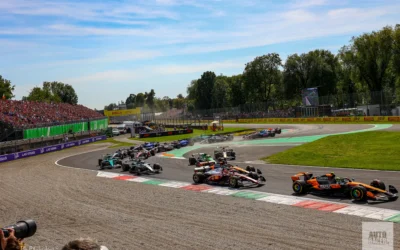The 2025 F1 season officially kicked off with a show at The O2 in London, where the championship’s 75th anniversary was celebrated. For the first time in history, fans were able to witness the live presentation of all ten teams and their 20 drivers.
Every F1 team unveiled their 2025 livery, with Ferrari taking to the track at Fiorano the following day with its SF-25. The Scuderia covered their first 200km with their 2025 car on a filming day.
F1 ground effect limited by mechanical simplification: Consistency takes priority over peak downforce
Generally speaking, the consensus among teams was there would be a lot of crossover between 2024 and 2025. However, as the races went by, they noticed that the new regulations (in their third year of application) have become too sensitive.
Throughout last season, many teams struggled with inconsistencies and troubles in optimising set-up.
Practically all the top teams, sooner or later, have fallen into the trap of reducing the working window of their cars. This, according to some engineers, is mainly due to the mechanical platforms.
“With the RB20, we lost aerodynamic load in some parts of the aerodynamic map,” explains Red Bull Technical Director Pierre Waché.
“We had holes and, consequently, we did not obtain the performance on the track that we saw in the wind tunnel.”

The regulations introduced in 2022 have significantly limited the mechanics of single-seaters since. In terms of internal components, only springs and shock absorbers can be feasibly used, eliminating the possibility of mounting dampers such as inertia.
These components were the basis of the previous regulatory cycle, and were very useful for controlling the vertical movement of the tyre. Alongside other regulatory simplifications, these components have drastically changed the mechanics of modern F1.
As a result, control of vehicle dynamics has been increasingly restricted. Teams have less and less wriggle-room in this sense.
Most technical experts agree that simplified suspensions have massively impacted floor clearance. This has a direct impact on performance and set-up work.
It is no coincidence that the teams are no longer chasing downforce peaks at all costs. Instead, they are pursuing optimisation across different circuit types and configurations.
Ultimately, it is more important to have a car with stable and predictable behaviour, rather than one with enormous potential but difficult to extract.
“The RB20 still had potential that we could not exploit on the track due to our budget problems.
“After Monza and Austin we improved the situation, but there was still a big step to make to fully exploit the potential.
“It is always a compromise. You have to lower the overall potential to obtain maximum performance and find a better balance” .
Ferrari SF-25: Pull-rod rear suspension mounts lowered to unlock aerodynamic gains
For this reason, on the 2025 cars we should expect numerous changes and optimizations especially in terms of vehicle dynamics, whether this is linked to the chassis and/or above all to the actual mechanical parts such as the suspension.
All to help aerodynamics, unlocking further potential to increase the much talked about operating window of the car and not so much and necessarily the peak load.
“We are in the fourth year of application of this regulation and we know our previous project very well. For this reason, the 2025 car will be completely new,” announced Fred Vasseur last Christmas, speaking to AutoRacer among others.
It is now well established that the SF-25 will be 99% different from the SF-24.
The Maranello team has revolutionised the front of its car precisely to unlock aerodynamic gains. Ferrari’s new front pull-rod is designed to generate greater load in that area, allowing the cockpit to be moved back and consequently moving the centre of gravity backwards.
“The Ferrari SF-25 is an evolution of the previous car, even if it is different in 99% of its components,” said Loic Serra at the SF-25 presentation.

However, there will also be some important changes at the rear. The Italian team has continued to focus on the rear pull-rod suspension. Haas are the only other team who will share this.
Ferrari still believe the push-rod does not provide such a big enough advantage to justify changing it. This belief was reinforced last season, where it’s absolute impact on performance was more greatly understood.
The major miniaturisation work on the internal components of the rear suspension, which began on the SF-23 and then continued on the SF-24 (different allocation), has allowed the Italian technicians to confirm the pull-rod suspension, with a solution that does not penalize aerodynamics too much.
Maranello’s engineers went further in this area on the 2025 car, trying to further optimise kinematics. The gearbox was (partly) lowered to lower part of the mechanical attachments.
Therefore, the 2025 spec diffuser will be further developed at Ferrari. This is because the gearbox will be even more immersed in the important aerodynamic macro component of the floor.
This innovation is designed above all to improve rear aerodynamics, both in terms of managing ride heights and hopping.
Let’s remember that the 2024 cars had very little ground clearance, and this could continue in 2025. And it is precisely here that the management of the mechanical platform will definitely come into play, to make the aerodynamic optimisations more impactful (chronometrically speaking) compared to competitors.




